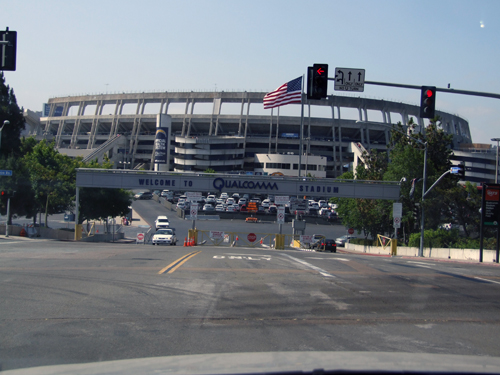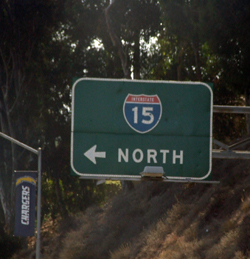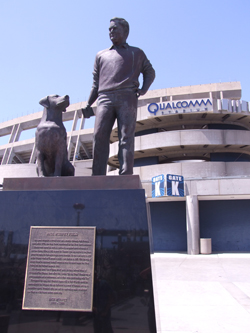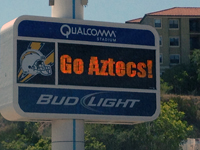
–First in a Series —
By Donald H. Harrison


SAN DIEGO – Qualcomm Stadium, as it called in its third incarnation since opening in 1967, is a massive concrete structure described as “modernist” by some architects, “brutalist” by others. Either way it is a celebration of structural forms and building materials. Its massive slabs of unadorned concrete give the impression of overwhelming power, not unlike that of a 320-pound tackle advancing on a 180-pound quarterback. Modernism is an architectural style that was made popular in San Diego four years earlier when polio vaccine discoverer Dr. Jonas Salk and architect Louis I. Kahn, two admired Jewish leaders in their fields, unveiled in La Jolla the Salk Institute for Biological Studies, an eye-arresting complex of buildings starkly beautiful as they overlook the Pacific Ocean.
Wherever you go in the world, if you look hard enough, you will find a “Jewish story. ” Sometimes those stories are obvious to anyone—a synagogue, a mikvah, a town named after a Jewish settler, a celebration of the Bible, or an ode to modern Israel. In other instances, the stories are not so obvious, they are strands in the tapestry of places that you might visit along the Interstate 15, places, for example, like Qualcomm Stadium., which is at the Friars Road exit in San Diego.
When the stadium opened for business, it was called simply San Diego Stadium. On Sept 9, 1967 , the San Diego Chargers, then of the American Football League, played the first official game of the season here. They had a Jewish coach by the name of Sid Gillman, who previously had led them through their paces at the now demolished Balboa Stadium. In 1963, under his guidance, the Chargers won the league championship with a commanding 51-10 defeat of the Boston Patriots. Perhaps because of all the excitement engendered by a new stadium, it looked like the Chargers would dominate the league again in 1967. In their first ten games of the season, they ran up a record of 8-1-1, but then disaster, in the form of the Oakland Raiders, struck. Having handed the Chargers their only loss earlier in the season, the Raiders did it again 42-21. The dispirited Chargers then lost the next three games to end up in third place with an 8-5-1 record. When Gillman and his all-American lineman Ron Mix, also Jewish, looked at each other, there was really only one thing to say: “Gevalt!”
If Gillman had something to cheer about, it was that NFL Commissioner Pete Rozelle took him up on his idea of having a game played between the champions of the National Football League and the American Football League. Today the Super Bowl is an American institution.
Anothr Jewish sportsman, Gene Klein, purchased the San Diego Chargers in 1966 and held onto the team until 1984. He also owned a basketball team in Seattle and raced thoroughbred horses. A friend and fan, Lou Harris, recalls that when Klein was asked to compare football and horse racing, he responded that when his horses win, they never ask for an increase in salary.
In 1968, the Chargers got some company at the stadium. A new tenant was the minor league Pacific Coast League team known as the San Diego Padres. The name was influenced by the fact that San Diego is home of California’s mother mission, Mission San Diego. The mission is within walking distance of the stadium, which is located in the Mission Valley neighborhood of San Diego fronting on Friars Road. In 1969, the Padres were accepted as an expansion team in the major leagues, and were assigned to the National League.
In the first game of its first Major League season, the Padres won 2-1 against the Houston Astros, but after that things just got worse and worse. The Padres would up their season dead last with a record of 52-110.
Although there have been distinguished moments in the history of the two professional franchises, the sad fact of the matter is that since the Chargers establishment, the team has thus far played in only one Super Bowl. The Padres have a slightly better record, having fought their way to two World Series. However, the San Diego teams lost all three of these championship games.

In 1980 San Diego sportswriter Jack Murphy died, and in appreciation for the key role he had played in getting professional teams to move to San Diego, and persuading voters to approve the bond issue to build the 50,000 seat stadium (it has since been expanded to over 70,000 seats), the stadium was renamed in his honor as San Diego Jack Murphy Stadium, or “the Murph” for short.
Later on, in 1997, naming rights for the stadium were sold for $18 million to Qualcomm, a digital communications company which was co-founded by two Jewish professors, Andrew Viterbi and Irwin Jacobs, both of whom today are major philanthropists for both Jewish and general causes. Murphy is still remembered because Qualcomm Stadium surrounds what is called Jack Murphy Field.
There is a statue of Murphy and his black Labrador hunting dog, Abe of Spoon River ,standing between one of the entrances to the stadium and the platform of the San Diego Trolley station serving Qualcomm. True, Murphy was Irish but in his Labrador, there was a Jewish story. Abe was short for Abraham. One of the puppies that dog sired was named Isaac. Alas, he wouldn’t hunt, so Murphy gave him away. The name of his third dog? You guessed it. Jacob.
As the Chargers early in their franchise had a Jewish player in Ron Mix, so too did the Padres have theirs in Brad Ausmus, who made his major league debut as a catcher in the 1993 season and stayed with the team until 1996 when he was traded to the Detroit Tigers, the team which he manages today.
Gillman, Mix and Ausmus all have been inducted into the National Jewish Sports Hall of Fame in Suffolk County, New York.
Not all the Jewish stars who performed at Qualcomm Stadium are so kindly remembered. In 1990, Roseanne Barr decided to make a comedy act out of singing the National Anthem before a Padre game against the Cincinnati Reds. She screeched out the words, and then in imitation of a baseball player, scratched her crotch and spat. The crowd didn’t care for the satire, and the booing, in the form of controversy, continued for many weeks thereafter.
Although the Chargers got to play in only one Super Bowl, the stadium has hosted three such contests featuring other teams. In 1988 the Washington Redskins defeated the Denver Broncos 42-10. Ten years later, in 1998, the Denver Broncos defeated the Green Bay Packers 31-24. And in 2003 Tampa Bay beat Oakland 48-21. Many Jewish San Diegans have been privileged to attend all three games, among them Charles Wax, chief executive officer of Waxie Sanitary Supply.
There also have been two All-Star Games played here. The National League won 7-3 in 1978, in a game in which a fellow who was often thought to be a Jew — but wasn’t — played. That was Rod Carew, then a first baseman for the Minnesota Twins. When Saturday Night Live’s Adam Sandler wrote his Chanukah song, one of the lyrics said that Rod Carew is a Jew–converted–but in fact he wasn’t and hadn’t. His wife was Jewish and their child was being raised Jewish, but Carew himself remained Christian. The other All-Star Game at “The Murph,” in 1992, saw the American League prevailing, 13-6.
Jews have moved in and out of the Padres front office as a succession of management teams came and went, but one well-known Jew who has been more or less a fixture for the Padres has been radio announcer Ted Leitner, who used to be the TV sportscaster on KFMB-TV, Channel 8. Leitner has the knack of giving running play-by-play descriptions while filling in those moments between the action with anecdotes about almost every professional player in every sport ever played in San Diego.

Photo: Shor Masori
The Padres moved from Qualcomm Stadium in 2004 to Petco Park in downtown San Diego, and the San Diego Chargers have been campaigning for a new stadium as well, sometimes broadly hinting if one is not forthcoming the franchised will be moved to another city. Meanwhile, Qualcomm Stadium remains the home field for the San Diego State Aztecs as well as the host to two college Bowl games played in the winter – the Holiday Bowl and the Poinsettia Bowl – each of which has enthusiastic fans. It also has been the venue for numerous concerts, religious revivals, home games of the short lived San Diego Soccers team, and has served as an evacuation center when major wildfires forced thousands of San Diegans to flee their homes.
Point of personal pride: When the late Tony Gwynn retired from baseball after playing all 20 seasons of his major league career for the Padres, there was a ceremony at Qualcomm Stadium that involved various VIPs followed by Tony and Alicia Gwynn walking through a 9-foot diameter baseball that had been crafted from balloons. The Jewish angle was that my daughter, Sandi Masori, and her husband, Shahar, owners of Balloon Utopia, made that giant baseball portal!
*
Harrison is editor of San Diego Jewish World. He may be contacted at donald.harrison@sdjewishworld.com